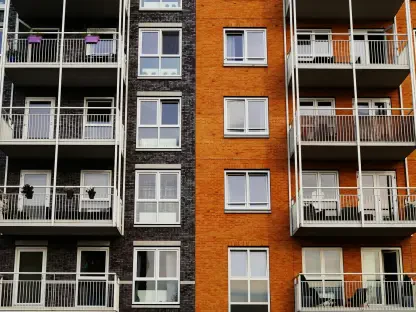The real estate scene in Greater New Bedford has gained significant attention due to its dynamic market activity and the diverse range of properties being transferred. Situated in a region rich with scenic beauty and community-centered amenities, the towns within Greater New Bedford showcase a real estate market that is both vibrant and complex. The area has seen considerable residential property transfers, with diverse homes changing hands, reflecting broader economic and sociocultural trends. By examining the recent wave of property sales in the region, one can gain valuable insights into local market dynamics and what drives these transactions. Housing options range from luxurious waterfront estates in places like Fairhaven and Westport to more affordable homes in communities like Fall River.
The Diverse Spectrum of Property Types
Luxury and Upscale Properties
In Greater New Bedford, the luxury segment of the real estate market has shown remarkable strength, highlighted by a rising number of high-value transactions. Waterfront locales such as Fairhaven and Westport, known for their stunning ocean views, maintain a particular allure among buyers seeking a combination of opulence and natural beauty. Properties in these areas often surpass the million-dollar mark, reflecting their aesthetic and lifestyle value. High-end buyers are drawn to these areas not just for their scenic vistas but also for proximity to vibrant community activities, exclusive recreational facilities, and access to top-tier schools. The sale of a property on Balsam Street in Fairhaven for $960,000 exemplifies buyers’ willingness to invest significantly in premium assets, which often come with extensive land and beautifully designed residences.
These upscale properties are frequently purchased by individuals and entities focused on lifestyle enhancements and long-term investment security. The presence of significant transactions involving trusts and real estate companies indicates a strategic approach to securing lucrative investments. Additionally, these transactions underline a trend where wealthy buyers aim to enhance their portfolios with properties that promise not just a home, but a lifestyle enriched by community vibrancy, often sought after by affluent investors. As high-net-worth individuals increasingly invest in these areas, the demand for high-end real estate continues to contribute to the area’s growth and economic dynamism.
Mid-Range and Entry-Level Markets
While luxury properties set high benchmarks in market value, the mid-range and entry-level housing sectors in Greater New Bedford also demonstrate considerable activity. This segment caters to families and individuals searching for affordability without compromising on quality of life and accessibility to essential amenities. Towns such as Fall River and New Bedford provide a spectrum of housing options ranging from modest suburban homes to spacious duplexes and condos, making them attractive entry points for first-time homebuyers. One specific example is a property on Division Street in Fall River, acquired at $260,000, highlighting the accessibility of good value homes in this region.
The shift towards more affordable homes aligns with broader socioeconomic trends, where budget-conscious buyers focus on strategic investments near urban centers offering employment opportunities, public transportation, and educational facilities. Community-driven initiatives often increase local market desirability, ensuring that while properties remain affordable, they do not lose urban advantages. For many buyers, these areas represent an ideal blend of cost-effectiveness and lifestyle, where residents enjoy suburban tranquility without disconnecting from urban necessities. Consequently, the demand for these homes continues to drive strong sales figures, underscoring the balanced nature of Greater New Bedford’s residential market.
Economic and Strategic Market Influences
Role of Real Estate Companies and Trusts
The involvement of real estate companies and family trusts in Greater New Bedford’s market has emerged as a predominant trend, marking a shift towards professional and strategic engagement within the sector. Institutions such as The Warren Group and Ladd Homes LLC are increasingly active, acquiring and managing properties with calculated precision, reflecting an overarching strategy to leverage the region’s growth potential. These entities are not merely participants in the market but play a crucial role in shaping its contours through acquisitions that align with broader investment goals. Their presence significantly influences market dynamics, as these companies often bring distinctive capabilities that enhance property values and boost the appeal of certain areas.
Furthermore, sales involving these organizations indicate a methodical approach to asset acquisition, linking real estate investments to long-term financial security and diversification strategies. A key pattern involves these entities targeting areas with promising development prospects or stable and growing rental markets, thereby ensuring future economic returns. The institutional involvement points to confidence in the local real estate market’s resilience and growth, highlighting the region as a viable option for those seeking steady property investment opportunities. Consequently, these systematic interventions often spur development and revitalization efforts within selected locales, driving up interest and property values.
Impact of Geographical and Demographic Factors
The geographical charm and demographic shifts within Greater New Bedford significantly impact market trends, seeing rising demand compatible with growing urbanization and lifestyle evolution. Seaside towns like Bourne and Mattapoisett, characterized by picturesque settings and tranquil environments, naturally attract potential buyers interested in recreation and a slower-paced lifestyle. The allure of these locations lies in their ability to offer serene getaways from metropolitan chaos, attracting retirees and second-home buyers alike. This coastal appeal combined with easy access to urban conveniences makes these towns prime spots for real estate investments.
Demographic changes, including an influx of younger families and professionals, are reshaping real estate demand patterns as well. Many choose to move into Greater New Bedford’s suburban settings to take advantage of affordable housing, excellent schools, and family-friendly communities. This shift prompts a wider range of property types being bought and sold, from modern condos appealing to millennial tenants to family-oriented properties emphasizing sustainability and community integration. The demographic evolution in these areas enhances diversity in market offerings, creating a dynamic environment where various housing needs are efficiently met by local market capabilities.
Understanding Unique Town Characteristics
Acushnet and Dartmouth: Tradition Meets Modernity
Acushnet and Dartmouth offer fascinating insights into how tradition and modernity coalesce within Greater New Bedford’s real estate landscape. Both towns are known for retaining their historical charm, with properties reflecting classic New England architecture, appealing to those seeking homes with historical significance and character. This preservation of heritage housing presents a unique selling point, especially to buyers who value architectural history and continuity with the past. The combination of rustic, historical charm, and modern convenience makes these locations ideal for individuals seeking a balanced lifestyle that nods to the storied past while embracing current advancements.
Simultaneously, emerging developments and modern architectural designs cater to a demographic eager for contemporary home features without sacrificing community ambiance. This blend of styles enables Dartmouth to accommodate diverse buyer preferences, including those desiring tech-enhanced smart homes or eco-friendly residences. Moreover, these areas have fostered environments where accessibility to contemporary amenities such as shopping centers, workplaces, and efficient transportation symbolize forward-looking growth. As such, the real estate market in these towns retains strong appeal by merging the allure of history with the demands of modern living.
Fall River and New Bedford: Urban Rhythm and Revitalization
Fall River and New Bedford reflect the urban pulse of Greater New Bedford, characterized by ongoing revitalization initiatives and burgeoning economic prospects. The vibrancy of these towns underscores a resurgence of interest from both investors and homeowners eager to partake in urban rejuvenation. Real estate in these urban centers mirrors this upward trajectory, with older neighborhoods undergoing transformative upgrades and new developments springing up to meet contemporary housing demands. This transformation not only breathes new life into aged infrastructure but also attracts residents and investors looking for strategic opportunities in modernization.
The collaborative effort between local governments and private investment groups has played a pivotal role in shaping these urban centers, ensuring new growth translates into sustainable living environments. Efforts are tailored to nurture community development, enhancing public spaces, and uplifting local business districts. Additionally, the introduction of cultural and educational hubs further fuels local economies, offering attractive options for younger generations seeking dynamic, vibrant urban settings. Such investments highlight the ongoing commitment to balanced urban growth and community welfare, reflecting Fall River and New Bedford’s ambition to become bustling urban havens with plenty to offer different demographics.
Future Considerations for Greater New Bedford’s Market
Sustained Growth and Emerging Opportunities
The sustainable growth trajectory of Greater New Bedford’s real estate market indicates numerous emerging opportunities for both residential buyers and investors alike. With consistently high demand for diverse property types across towns and cities, stakeholders find themselves well-positioned to capitalize on evolving market trends. Sustained community investment in infrastructure, education, and lifestyle amenities makes the region increasingly appealing to both developers and prospective homeowners seeking favorable returns on investment and a high quality of life. As New Bedford continues to develop, maintaining the allure of semi-urban living while retaining small-town charm seems paramount to sustained market interest.
The adaptability of the market to accommodate shift-driven trends, ranging from urbanization to economic diversification, reflects its robust resilience and growth potential. Looking to the future, it will be crucial to remain attentive to external economic factors, such as interest rate fluctuations and macroeconomic shifts. Strategic foresight and market awareness will thus be essential for stakeholders as they navigate the evolving real estate landscape in Greater New Bedford. Continued focus on sustainable development practices and diversified property portfolios will likely underpin the region’s capacity to thrive as an attractive and competitive market.
Navigating Challenges and Enhancing Community Appeal
The luxury real estate market in Greater New Bedford has displayed notable strength, marked by a rise in high-value property transactions. Areas like Fairhaven and Westport, celebrated for their breathtaking ocean views, continue to captivate buyers who desire both luxury and natural beauty. Properties in these coveted spots frequently exceed the million-dollar threshold due to their aesthetic appeal and lifestyle enhancements. Buyers are drawn not only to the scenic backdrops but also to the vibrant community activities, exclusive recreational amenities, and top-notch schools these areas provide. A recent $960,000 sale on Balsam Street in Fairhaven highlights the readiness of buyers to make significant investments in premium real estate assets, which often come with extensive land and architecturally impressive homes.
These luxurious properties are commonly purchased by individuals and entities seeking lifestyle enhancement while ensuring long-term investment security. Records of significant transactions involving trusts and real estate companies point to a calculated strategy aimed at acquiring profitable investments. Furthermore, these transactions highlight a trend where affluent investors aspire to elevate their portfolios with properties promising not just homes but a lifestyle enriched by community vibrancy. As wealthy individuals increasingly invest in these regions, the demand for upscale real estate continues to fuel local growth and economic vitality.









